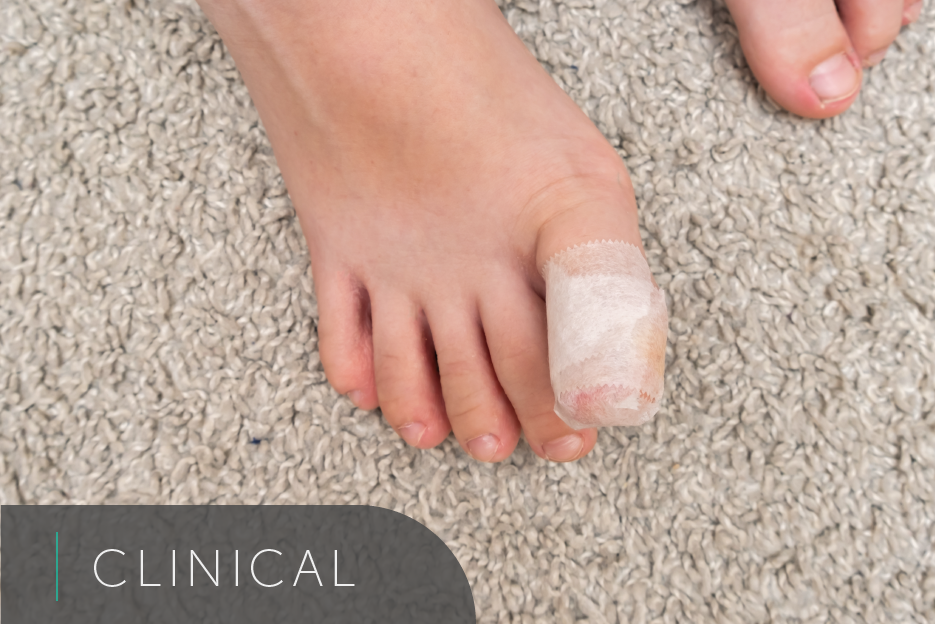
The dreaded ingrowing toenail, not everyone has experienced them but those who have will tell you that it can be quite debilitating. An ingrowing toenail, which commonly affects the big toe, is where the edge of the nail has curled down the side of the toe (nail sulcus) and broken the skin. The break in the skin is an important factor. Many people will see me with concerns of having a ingrowing toenail but after an assessment, the skin is not actually broken. These would be described as involuted, they can be quite painful and cause discomfort, but they are generally treated more conservatively. An involuted nail edge can still press into the skin and commonly has a build up of hard skin around it that adds to the pressure felt.
There are multiple to reasons they occur, for example those who have natural more curved (involuted) nails are more at risk of ingrowing. Trauma is common such as being stepped on, tight footwear or a poor cutting technique leading to a sharp edge in the side of the nail can all contribute.
What are my treatment options for an ingrowing toenail?
There are multiple treatment options to resolve an ingrown toenail depending on the history, presentation and our assessment of the condition. In the first instance I will almost always advocate for conservative treatment. This involves trimming the ingrown edge away and then filing it to make sure it is smooth and rounded. I will then advise to continue dressing the toe as you would any break in the skin until it is healed and monitor as it grows that it does not occur again.
For some, the toe may be too irritated and painful to remove the nail edge so we can administer a local anaesthetic to the toe. This will numb the digit to allow us to safely perform the conservative treatment.
A surgical option is also available. I will generally recommend this if conservative is not possible or has failed or if the shape of the nail means that this will be an ongoing. Nail surgery does make it sound scarier than what it is. The procedure is done within our normal clinic under local anaesthetic and can be done in less than 30 minutes. This option is the permanent removal of the nail edge or the entire nail from where it grows out. A liquid known as Phenol is applied to essentially cauterise where the nail grows out. This essentially prevents nail regrowth to reduce the risk of the IGTN occurring again.
Common questions
Do I need antibiotics?
The podiatrist will be able to assess the toe then make a recommendation to see a GP for a course of antibiotics if indicated. Commonly, people will present after already being treated with 1-2 courses of antibiotics, but their symptoms keep persisting once they stop taking them. A potential reason for this is that the toe in that instance may not actually be infected. When the nail edge is ingrowing into the broken skin the body will treat it like a foreign body. The toe will therefore have an inflammatory response similar to that of an infection (redness, swelling and pus). In these patients once the edge is removed the symptoms generally resolve if there is no infection present.
Is an ingrowing toenail painful?
Some pain and tenderness can be experienced during conservative treatment. However, once we remove the ingrown nail edge, this settles quickly once the edge is removed. If it is deemed too painful generally one of the options with local anaesthetic would be recommended. When the local anaesthetic wears off most people report minimal pain and require no pain medication but some will use paracetamol for the 1st day.
Is the healing process long following surgery for an ingrowing toenail?
Time to heal is generally 4-6 weeks but this can vary depending on multiple factors. These factors include whether it is a partial or total nail removal, circulation to the foot, medical history, etc. The podiatrist will assess these factors and advise you from there.
Are there any risks with nail surgery?
With any procedure there are always risks involved but we do everything in our power to mitigate these. Due to the nail being removed from the base of the toe a small wound is created. This will pose a risk of infection. There is also a risk of having an adverse reaction to the local anaesthetic. This is something we monitor closely and epi-pens are stored on site. The liquid Phenol which is applied to prevent the nail growing back is classed as an acid. There is a risk of an acid burn to the skin but we apply very cautiously. The toe is cleaned following the application to remove any remnants of the liquid. We make every effort to make sure risks are low, but is important to be aware of them.
As always this advice is we recommend seeing a HCPC registered podiatrist for an individual assessment and management.